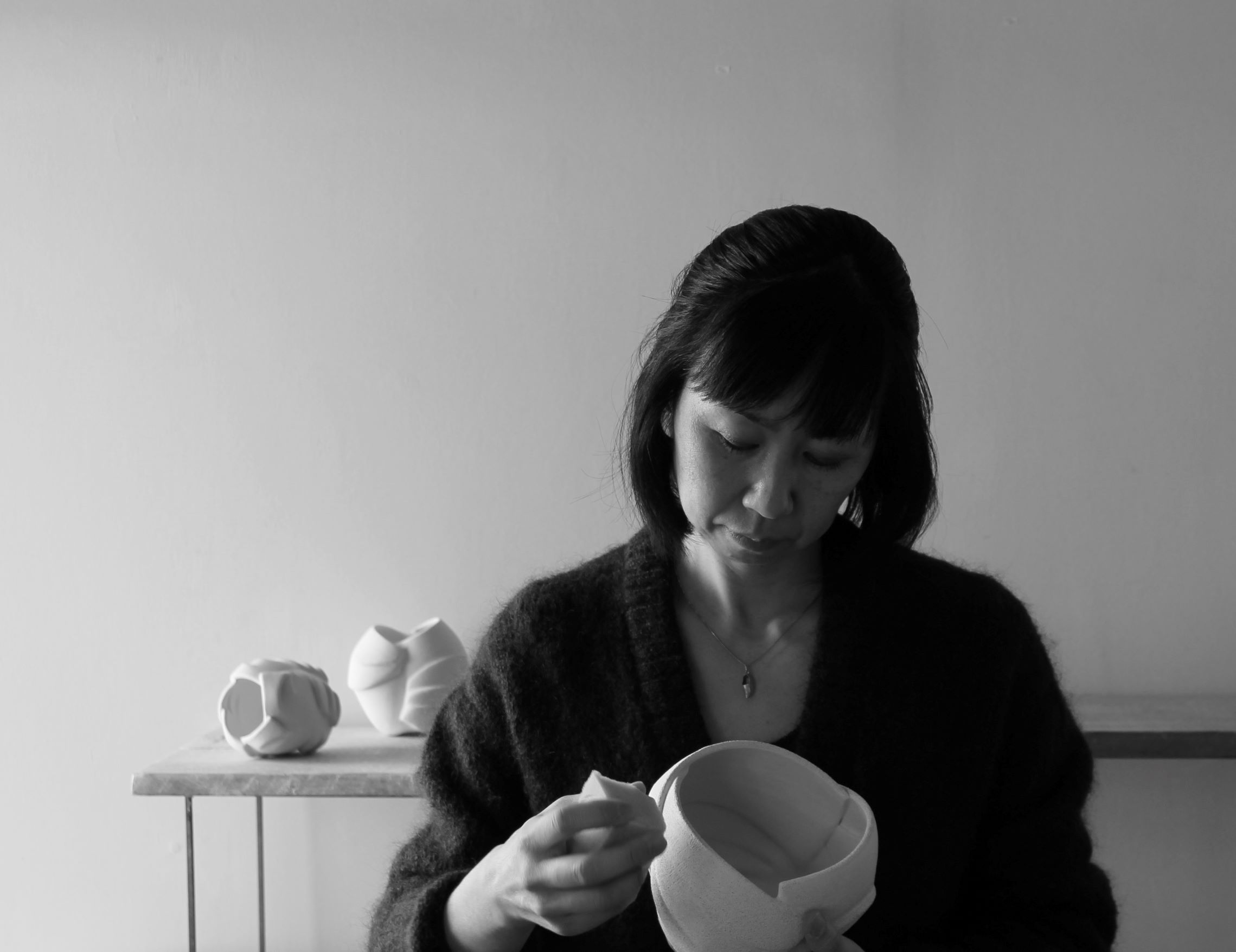ABOUT
Umi Amanuma is a ceramist living and working in Fiesole, a village a few kilometres from its bigger
neighbour, Florence, in Italy. She identifies with Albert Einstein’s renown quote: “look deep into
nature and you will understand everything better.” There is no better setting than Fiesole, where
the natural world peaks all around her. In her most recent series, she has developed a deeply
meaningful set of principles through her ceramic practice, based on the characteristics of petals,
flowers, germination, blooming and division. With varying shapes appearing inside and out of her
works, her objects can be singularly compared to the very germinating plants she is so focused on,
and specifically the animation in this action. Like props from a cult science fiction story, or
creatures from an Hayao Miyazaki animation, her biomorphic objects are like nature morte
cartoons.
Umi Amanuma’s expressions of germination, blooming and division are made with single, two, four,
or more segments appearing as if they are just about to blossom into another form. The
curvaceous objects, frozen in time and space, are sculptural entities that have interior and exterior interactions; visibly positive and negative spaces, each forming new shapes. Umi thinks bi-dimensionally whereby her 3-D objects are like drawings coming into physical space rather than simply on paper. Her practice is an exercise to understand nature’s artistic expression of germination, blossoming and flowering. Moreover, she transforms her works by means of incising linear patterns onto their surfaces adding movement in the objects, thus making them more
animate.
Umi Amanuma’s works are categorised into several classifications as in botanical methodologies.
“Growth,” “Open Blooms,” “Earth Flowers,” “Cotyledons” and “Germs.” Each group has their
specific characteristics such as how the geometrical patterns are formed in the “Earth Flowers,”
the varying heights reached by the gesturally shaped works in the “Growth” group or the multitude
of varying positions between the single pieces of the “Cotyledons.” As many are made in a diverse
array of clays and glazes, or left with bare monochromatic surfaces, these works share in the
collective consciousness of planet earths magnificent array of creation. This culture is timeless and
global.
In contemporary culture, the art of ceramics achieves a role beyond the once thought of functional
object. Such contemporary artists such as Fausto Melotti, Arlene Schechet, Per B Sundberg or
Emanuel Boos, to name a few renown ceramists, have expanded the vision of ceramics as an art
form beyond functional craft and into a hybridised abstract and figurative sculpture. As
contemporary Italian sculptors such as Arnoldo Pomodoro have created works appearing to be
caught in the process of gradually transforming one object into another altogether, similarly, Umi
Amanuma’s recent ceramics takes part in this notion whereby the functional object gradually
transforms into a sculptural object. The vase is no longer a vase, but a work of art, having the
potential to continuously change under observation.

Umi Amanuma è una ceramista che vive e lavora a Fiesole. Lo spirito che muove il suo lavoro si può
cogliere con la famosa citazione di Albert Einstein: “Osserva nel profondo della natura e allora
comprenderai meglio ogni cosa”. Nella serie più recente dei suoi lavori, Umi ha sviluppato dei
principi profondamente significativi della sua pratica di ceramista, che si fondano sulle
caratteristiche intrinseche dei petali, dei fiori, della germinazione, della fioritura e della divisione.
Con le molteplici forme che appaiono dentro e fuori i suoi oggetti, le sue opere possono essere
paragonate alle piante stesse osservate dall’artista, nel momento della germinazione e in
particolare nell’ animazione di questo atto. Come gli oggetti di scena di una storia di fantascienza
cult o le creature di un’animazione di Hayao Miyazaki, i suoi oggetti biomorfici sono come una
natura morta animata.
Umi rappresenta la germinazione, la fioritura e la divisione attraverso due, quattro o più sezioni che
sembrano sul punto di sbocciare in un’altra forma. Gli oggetti curvilinei, congelati nel tempo e nello
spazio sono entità scultoree che hanno interazioni al loro interno e al loro esterno; generano spazi
positivi e negativi, formando di volta in volta una nuova forma. L’artista pensa
bidimensionalmente, per cui i suoi oggetti 3D sono come disegni che entrano nello spazio fisico
piuttosto che sulla carta. Il disegno è per lei un esercizio per comprendere l’espressione artistica
della natura nelle fasi di germinazione, sbocciatura e fioritura. Inoltre, Umi trasforma le sue opere
incidendo pattern lineari sulle superfici, che donano agli oggetti una sorta di slancio, rendendoli più
animati.
Le opere di Umi Amanuma sono suddivise in diverse classificazioni come nelle metodologie
botaniche: “Crescita”, “Fioritura”, “Fiori di terra”, ”Cotiledoni” e “Germi.” Ogni gruppo ha le sue
caratteristiche specifiche, come possono essere le forme geometriche dei fiori di terra, le diverse
altezze raggiunte dal gruppo della “Crescita” o la moltitudine di posizioni variabili tra i singoli pezzi
dei “Cotiledoni”. Poiché molte di queste opere sono realizzate in un’ampia gamma di argille e
smalti, o sono lasciate con superfici monocromatiche nude, esse partecipano alla coscienza
collettiva della magnifica creazione del pianeta Terra. Questa cultura è senza tempo, globale e
contemporanea.
Nella cultura contemporanea, l’arte della ceramica acquisisce un ruolo nuovo rispetto a quello
unicamente funzionale di una volta. Artisti contemporanei come Fausto Melotti, Arlene Schechet,
Per B Sundberg o Emanuel Boos, per citare solo alcuni famosi ceramisti, hanno contribuito ad
ampliare la visione della ceramica come forma d’arte oltre l’artigianato funzionale, creando sculture
ibride, astratte e figurative. Come gli scultori italiani contemporanei, tra cui Arnoldo Pomodoro,
hanno realizzato opere che sembrano essere colte nel processo di trasformazione graduale di un
oggetto in un altro, le recenti ceramiche di Umi Amanuma fanno parte della stessa idea per cui
l’oggetto funzionale si trasforma gradualmente in oggetto scultoreo. Il vaso non è più un vaso,
ma un’opera d’arte, che si trasforma, se osservata da diverse prospettive.

